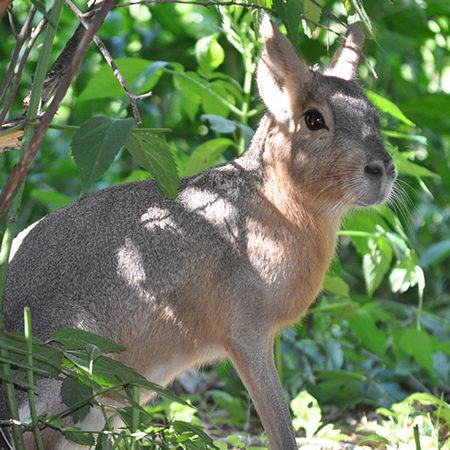Patagonian Cavy
Dolichotis patagonum
The Patagonian Cavy, is a part of the Mara genus, and is also known as the Patagonian mara, Patagonian hare, or dillaby. This animal can be described as resembling a jackrabbit, it is found living in open habitats in Argentina, and parts of Patagonia. The Patagonian cavy has distinctive long ears and long slender limbs, with its hind legs being more muscular. Its feet are compressed, making them hoof-like, its tail is short and hairless. The average Patagonian Cavy is 2 - 2.5 feet long, weighing between 18 - 35 pounds.
Living in Argentina, they prefer to stay in habitats with shrub cover, but can also inhabit overgrazed and barren soil lands. They are herbivorous animals, spending days foraging for plants, flowers, and vegetables. They have well adapted to this cursorial (adapted to running) lifestyle on the open plains, with long legs and developed sensory organs. They are primarily diurnal spending the majority of their days feeding.
Patagonian Cavies are social animals, with unique social organizations. They are known to be monogamous, but will breed communally. A monogamous pair will stay together for life, with replacement of partners only after one’s death. The male will follow the female wherever she goes, marking the ground around her as their territory.

The Patagonian Cavy is only found on the South American continent in Argentina.
HABITAT -They inhabit shrub lands and barren soils of Argentina.
DIET -They are herbivorous, eating a plant based diet, foraging for plants, flowers, and vegetables.
FUN FACT -They are the world's 3rd largest rodent, second only to the Capybara and Beaver.
SOCIAL BEHAVIOR -They live in monogamous pairs, living in social organizations.
ACTIVITY -They are diurnal, being most active during the day and resting in the evening.
PREDATORS -Predators include grisons, foxes, and large birds of prey.
SIZE -They are between 2 - 2.5 feet long, weighing between 18 - 35 pounds.
RELATIVES -They are distant relatives to the Guinea Pig and Capybara.
CONSERVATION -The Patagonian Cavy is categorized as NT (Near Threatened) by the IUCN.
Cub Creek Animal Care Information
Housing - Our Patagonian Cavies are spread out amongst four groups living in large outdoor enclosures of Lemur Island and the Pentagon. These enclosures have large amounts of lush grass, brush, and trees to simulate a natural environment. They have automatic water dispensers in their enclosure ensuring fresh water at all times. There are also covered shelters, bedded with shavings within the outdoor enclosure.
Diet - Range cubes and rabbit pellets is a mixture of dry food we feed our cavies that is a staple in their diets. These dry foods are totally cooked and supplement with a blend of protein, minerals, and vitamins. They also receive a variety of greens, diced sweet potato, and apples. They also enjoy special treats like dried fruits outside of what they regularly eat.
Enrichment - Our Patagonian Cavies receive plenty of one-on-one attention and socialization with campers during the summer and our animal team in the off-season. Campers will make special toys for them to play with cardboard and other materials, they have also made special fruit popsicles for them!


